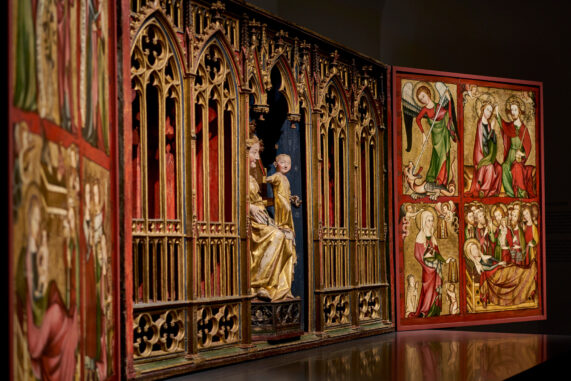
About the Exhibition
Owing to fortunate circumstances, a unique ensemble of late thirteenth and early fourteenth-century liturgical and paraliturgical objects has come down to us from a former convent at Altenberg an der Lahn. Every one of these objects alone can already be considered among the absolute gems of the period.
For the first time since the convent’s secularization in the early nineteenth century, they were brought together again in the exhibition “Heaven on Display”, granting visitors the opportunity to experience one of the qualitatively most superb choir ensembles of the Middle Ages.
At its centre, the exhibition featured a folding altarpiece measuring some 4.9 metres in width. Consisting of a shrine cabinet, a statue of the Madonna and wings, it unites works of painting, sculpture, textile art and goldsmithery in a complex inter-referential system of altar imagery. From about 1330 onward, this retable, which forms the core of the ensemble, decorated the main altar of the convent church built between 1260 and 1270. The altarpiece wings already entered the Städel collection and its superb holdings of Early German painting in 1925.
The presentation in the exhibition gallery of the Department of Prints and Drawings allowed visitors to experience first-hand the fascinating interplay between various pictorial media in an ensemble of early fourteenth-century choir furnishings. Within this context, particularly in view of the sophisticated iconography of the linen embroideries and the recently rediscovered original paintings on the sides and back of the shrine cabinet, questions arise as to the accessibility of the imagery on and around the high altar and its reception from close quarters.
Curator: Prof. Dr. Jochen Sander (Vice Director and Head of Dutch, Flemish, and German Painting before 1800, Städel Museum)
Research
X-ray Fluorescence Analysis of the Altenberg Altar’s Shrine
The shrine’s investigations that became possible in the course of the preparation for the exhibition, produced many unexpected results which shed a new light on the original arrangement and function of this early high altarpiece. As the X-ray fluorescence analysis could not be fully assessed until after the catalogue’s printing, the results are being published here.
Sponsors
Supported by
Kulturstiftung der Länder

